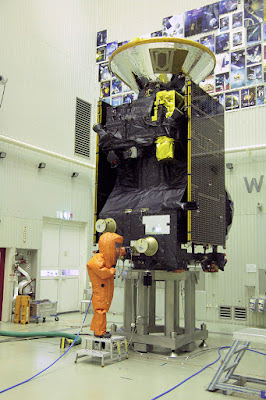Maximum Mag +4.3 Minimum +16.2
RA 18h 36m 56.84s DEC -28° 55′ 39.8″
I would like to encourage Astro photographers
living in the southern hemisphere to once again take images of the location of the
nova because there are signs of nebulae. You may find something interesting in
your image; however, it will be faint.
ASTRONOMERS at the Physical
Research Laboratory, India, led by Dipankar P.K. Banerjee have carried out
infrared observation of Nova Sagittarius which became a naked-eye object a year
ago. There is an indication of a hot gaseous central object surrounded by dusty
nebulae.
We report near-infrared
observations of V5668 Sgr on 28.96 February 2016 with the 1.2m Mount Abu
telescope. Spectra were obtained in the 0.9-2.4 micron region at a resolution
of ~ 1000 using the NICS imager-spectrograph system. Nova Sgr 2015,
discovered on 15.634 March 2015, underwent a deep dust formation episode in
June-July 2015. The present NIR photometry yields J = 9.88, H = 8.84, K = 7.08
(typical error 0.02 to 0.05) indicating that an infrared excess - due to dust -
is still present. The dust emission has however weakened from earlier as
evinced from the (J,H,K) magnitudes on 2015 October 25.60 and 2015 November
5.55 of (7.70 p.m 0.06, 6.05 p.m 0.04, 4.00 p.m 0.10) and (7.87 p.m 0.12, 6.20
p.m 0.13, 4.17 p.m 0.18) respectively. These were our last observations before
the nova's conjunction with the sun.
In stark contrast to the presence
of emission from a cool dusty component, coronal emission from a hot gaseous
component is also present. This is a rather unusual and unique symbiosis to be
witnessed in a nova's environment. The coronal lines that are clearly detected
are [Si VI] 1.9641 micron which is strong, and [Ca VIII] 2.3205 micron. The [Si
VI] line has a distinct profile with the line having two strong blue and red
peaks with a very deep drop in between at line center. There is also a
prominent line at 1.5503 micron that has been previously attributed to [Cr XI];
Br 10 at 1.7362 micron appears stronger than expected which could be due to a
contribution from [P VIII] expected at the same wavelength. Hydrogen Paschen
and Brackett lines are prominent, as also HeI, HeII and OI lines. HeI 1.0831
micron is overwhelmingly the strongest line in the spectrum.




































